|
|
German Binoculars page 7 pages: (1) (2) (3) (4) (5) (6) (7) (8) (8a) (9)
Carl Zeiss London 1917; Carl Zeiss West Germany 8 x 30 B; Carl Zeiss West Germany 8 x 30; VEB Carl Zeiss aus Jena 7x50W Jenoptem
|
|
|
|
|
|
|
|
Carl Zeiss London Ltd 6 x 24 - 1917
We are presenting another old and in some way unusual binocular in our collection - Carl Zeiss London Ltd. Carl Zeiss opened own affiliates, in London as well.
Thomas Antoniades, after years of research, says in his article “Carl Zeiss London Ltd”: ‘ [...] reasons it was decided to form a Limited company so as to formalize the presence in Great Britain and this was done on 2 November 1909 with the formation of Carl Zeiss (London) Ltd. The registered office of the company was at Great Castle Street in central London and its Board of Directors comprised primarily of German individuals.’
During the WWI the Carl Zeiss optical workshop was bought by Ross Ltd (London -Clapham), on 13 June 1917. The transaction was carried out on the basis of the act “The trading with the enemy Amendment Act 1916” -as we can read in William Reid book “Barr & Stroud Binoculars and the Royal Navy”.
More details about this transaction is given Thomas Antoniades.
However, the binocular was listed in the “Handbook of Artillery Instruments” in 1914. The book was printed under the authority of His Majesty’s Stationery Office. In the ‘Preface’ we can read: “The book is corrected up to April 1914..” The book is in our collection.
In the Chapter II - “Binoculars” are listed Galilean and Prismatic binocular in the Artillery Service. In the table of the binoculars is specified - “Binocular, Prismatic, No. 3, Mk. II” (page 33).
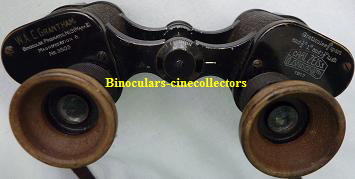 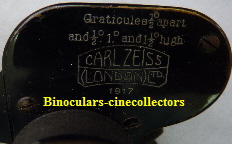 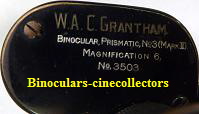
Pict 1; Carl Zeiss London Ltd 6x ;1917 in our collection ; Copyrights pictures Anna Vacani
In this chapter is made a comparison between the two models: 6x Ross and 6x Zeiss.
The binocular is described in the book as “The Zeiss pattern, although it has a smaller field than the Ross pattern, has greater brilliancy”. Nevertheless, the measures of the field of view for the Zeiss model are given twice as: 6Ëš 50’ and 6Ëš 20’.
Next we are reading: “The principal differences are that those made by Ross have the hinges formed from the cover plates, whereas those made by Zeiss have the hinges formed on projections from the aluminium bodies.”
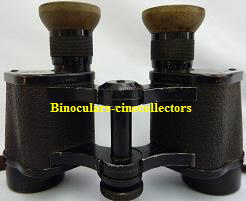 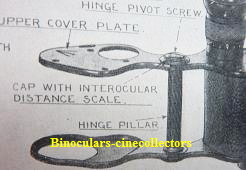
Pict 2; Carl Zeiss London Ltd 6x ;1917 in our collection; © A. Vacani; Pict 3; Ross const.; Pict. from the book -“Handbook of Artillery Instruments”
External features
The binocular body is made of aluminium alloy with Vulcanite covering. Other parts made of brass - cover plates, objectives and eye tubes. Ebonite eyecups are screwed on to the eyepieces. Each eyepiece can be focussed independently. The oculars can be focused from -5 to +5 diopter.
When the interocular distance is known it can be set for the user by the ring fitted at the end of the hinge.
On the right plate (Pict 1) is engraved: Carl Zeiss London Ltd logo and the measurement of the Graticule. The Graticule in our binocular is missing.
On the left plate is engraved - Binocular Prismatic, No.3 (Mark II) Magnification 6 No 3503. Above this description is the name of the previous owner.
On the rims of the cover plates are two numbers; on the right rim - L4895; on the left rim -L459170. The explanation of the numbers on the binoculars Carl Zeiss London Ltd, read in Thomas Antoniades article.

Pict 4; Carl Zeiss London Ltd 6x ;1917 in our collection; The numbers on the rims; © A. Vacani;
The binocular has broad arrows on the objectives cover plates:  Pict 5; Carl Zeiss London Ltd 6x ;1917 in our collection; the arrows © A. Vacani; Pict 5; Carl Zeiss London Ltd 6x ;1917 in our collection; the arrows © A. Vacani;
As we are reading in William Reid book; page 124; “Two arrows confront, ie having their points touching, indicates as early as 1882 that was formerly in service use had been sold by the relevant government department as surplus to its requirements”
The binocular dimensions are:
Width (fully extended) over the prism house - 140 mm (5.51 in) and underneath of the objectives - 155 mm (6.10 in) ; height 220 mm (8,66 in);
Weight 494 g (1,08 lb).
Internal features
The binocular is prismatic - Porro I optical construction. The eyepiece contains three lenses. The one nearest to the eye is achromatic, being made in two pieces cemented together with Canada balsam, and the other one is a single lens.
The objective consist of two lenses cemented together and mounted in eccentric rings.
Originally, the right eyepiece is fitted with a glass plate having Graticule engraved on it.
|
|
|
|
|
|
|
|
Carl Zeiss West Germany 8 x 30 B
The binocular was produced by Carl Zeiss West Germany in Oberkochen up to 1964. In 1964, the production of Zeiss binoculars was switched to Wetzlar in Hensoldt Zeiss factory. When Germany was partitioned, as far as to 1972, the Company used logo - Carl Zeiss. Since 1972 the logo changed and the binoculars were marked - Carl Zeiss West Germany. A short his you can read in our description of the Diadem Theater Glass West Germany.
The 8 x 30 B model was built for the wearers of spectacles. In 1958 Zeiss introduced the first B-type binocular giving a maximum field of view to spectacle wearers.
It is described in the “Carl Zeiss binoculars” catalogue - 1966 - in our library:
“Apart from the inconvenience caused y the constant need to remove spectacles to use the binocular, it was quite impossible to correct astigmatism without corrective lenses specially made to order for the user. [...] With the 8 x 30 B these drawbacks are eliminated by using a new type of eyepieces which increases the distance between the exit pupil and the vertex of the eyepieces lens. Reversible, soft rubber eyecups permit easy conversion to use by spectacle wearers. With a conventional binocular, the spectacle wearer will see only a small portion of the field [...] while a B-type binocular gives maximum field of view”.
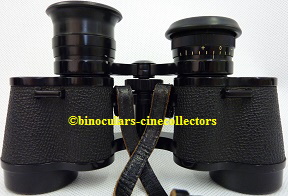
Pict 1; Carl Zeiss West Germany 8 x 30 B, with folded eyecup, in our collection ; © Anna Vacani
The 8 x 30 B was produced from 1958 to 1978. It was produced two models of this binocular; the first model with filed of view 110 m at 1000 m and second model since 1968, with 130 m of field of view.
Our binocular is the first model.
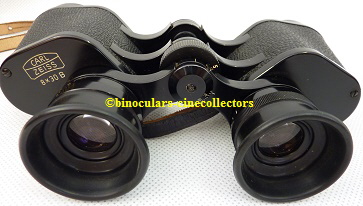 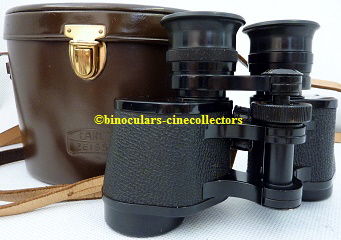
Pict 2, 3; Carl Zeiss West Germany 8 x 30 B, in our collection ; © Anna Vacani
As we have studied a technical documentation (in our library), during the time of production it was two small technical changes in the body house of the binocular as the internal mounting of the oculars and to do with the bending bar.
Exit pupil of the binocular is 3.75 mm.
External features
The binocular body is made of aluminium alloy with Vulcanite covering. The eyecups are made of soft rubber, easily folding. It is a central focusing binocular. The right ocular can be focused. We can adjust the complete sharpness with the wheel mounted under eye bending bars - focusing from - 5 to +5 diopter.
On the left plate is engraved: Carl Zeiss logo and magnification.
The fitting of the strap is exceptional. The strap is inserted into the specially made holes in the top hinge bars.
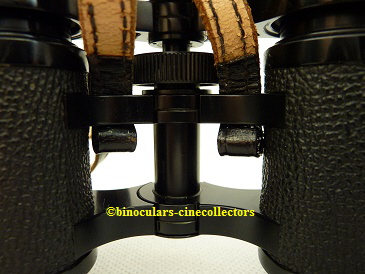
Pict 4; Carl Zeiss West Germany 8 x 30 B, with the strap fitting, in our collection ; Copyrights pictures Anna Vacani
Our binocular has additional hooks for strap, on the body, where usual the straps are fitted on the binoculars (Pict 1) .
On the washer is engraved production number and Made in Germany.
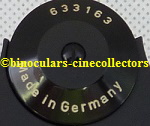
Pict 5; Carl Zeiss West Germany 8 x 30 B, the washer; Copyrights pictures Anna Vacani
Our binocular is in as new condition.
Internal features
The binocular is Porro I optical construction. The eyepiece contains five elements. The objective contains two air space elements. The lenses are coated.
Rubber seal sealing on the body parts.
The binocular dimensions are:
Width (fully extended) over the prism house - 150 mm (5 29/32 in); underneath of the objectives - 170 mm (6 11/16 in); height - 91 mm (4 in); weight 490 g (18 1/2 oz).
The binocular was very popular in the UK. In the price list, valid from May 1965 - the price was £45 and 15 shillings. In September 1966 - the price, with case was £78 and 3 shillings. The binocular was listed for sale in Zeiss binoculars catalogue in 1976, as well.
In our collection is Carl Zeiss Monocular 8 x 30 B, as well.
|
|
|
|
|
|
|
|
Carl Zeiss West Germany 8 x 30
The binocular was produced by Carl Zeiss West Germany in Oberkochen in 1954. It was the first binocular produced in Oberkochen, with a newly designed optical system.
This model was produced up to 1971. It was manufactured six version of the binocular. The changes were not big. In the technical documentation it was described as, in model:
I. Knurled screws in the right eyepiece is visible;
II. Screws are not visible because of pressed rubber cuff;
III. Threads not visible, rubber cover held on by a threaded ring. (Slots visible on the underside of the bridge);
IV. As model III, but changed prism attachment, funnel instead of the cover plate behind Objective (identified in objective sided glimpse of grooves);
V. As model IV, but changed eyepiece management (instead of fitting cylinder guide beads) and pointed instead trapezoidal thread eyepiece to center wheel and setup. - Recognizable from the outside to the width of the hinge arms (12.5 instead of 11.5 mm).
VI. Changes to joint housing and bridges. From the outside, recognized by higher lower hinge arms.
This model was described in the “Carl Zeiss binoculars” catalogue - 1966 as; “This is popular all-purpose model. Its 8 x magnification and its excellent performance [...] make it the perfect companion for travel, sports and wild-life studies. It is also a grate favourite among hunters.”
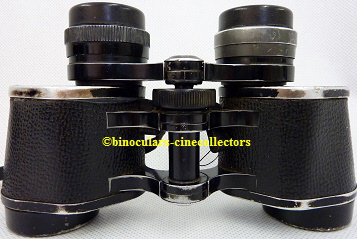 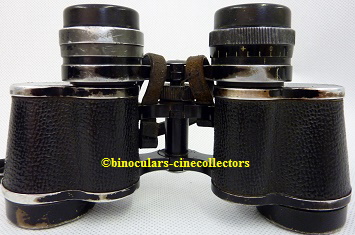
Pict 1, 2; Carl Zeiss West Germany 8 x 30, in our collection ; Copyrights pictures Anna Vacani
Many features of this model is similar to the model 8 x 30 B, including exit pupil of the binocular is 3.75 mm. The filed of view of 150 m at 1000 m
External features
The binocular body has only a few differences; is only one kind of fitting straps, in the top hinge bars (Pict 2). The eyecups are made of a hard plastic material. The 8 x 30 B model has larger diameter of eyepieces.
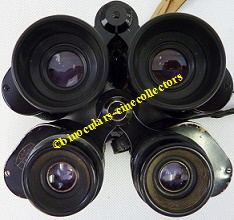
Pict 3; Carl Zeiss West Germany 8 x 30 & 8 x 30 B eyepieces, in our collection ; Copyrights pictures Anna Vacani
On the left plate is engraved: Carl Zeiss logo and magnification. The production No 500113- is on the bottom washer;
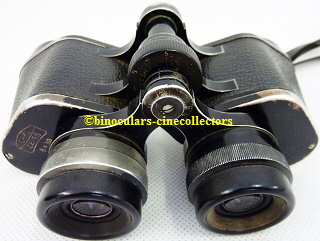 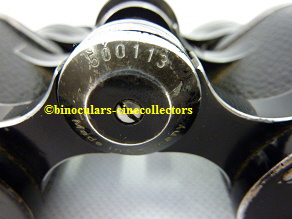
Pict 4, 5; Carl Zeiss West Germany 8 x 30, logo & prod No, in our collection ; © Anna Vacani
Internal features
The binocular is Porro I optical construction. The eyepiece contains six elements, one more than model 8 x 30 B. The objective contains two air space elements. The lenses are coated.
Rubber seal sealing on the body parts.
The binocular dimensions are:
Width - 165 mm (6.5 in); height - 170 mm (3.7 in); weight 496 g (17 1/2 oz).
|
|
|
|
|
|
|
|
Carl Zeiss DDR Germany aus Jena 7 x 50W Jenoptem
The binocular was produced by VEB Carl Zeiss Jena of East part of Germany - DDR, in 1975. It is central focus binocular (CF).
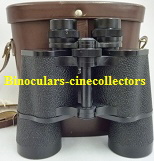 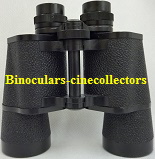 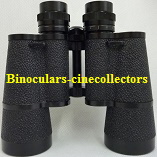 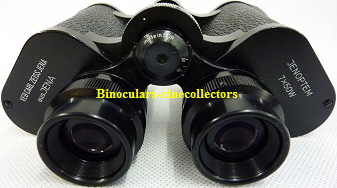
Pict 1, 2, 3, 4; 7x50W Jenoptem in our collection, No 4226616; © Anna Vacani
The description on the left plate indicates that it was produced for West German market, in that case in a binocular description was added “aus Jena” - from Jena not manufactured in West Carl Zeiss Oberkochen (see above description). The description is different from other binoculars produced in Carl Zeiss Jena DDR because the Carl Zeiss Jena was legally forbidden to use original Carl Zeiss logo for binoculars produced for export to West Germany.
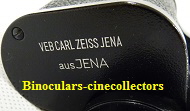 
Pict 5,6; 7x50W Jenoptem the left and right plates;No 4226616; © Anna Vacani
The same model produced for any other countries, or internal use, were marked with Carl Zeiss Jena logo and Made in DDR on the top washer - it is in our collection No 4187394 (produced in 1974).
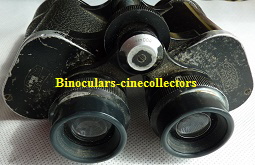 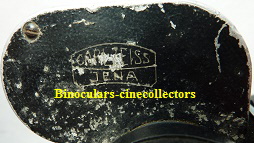 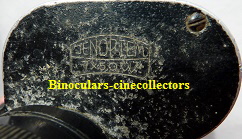
Pict 7, 8, 9; 7x50W Jenoptem Carl Zeiss Jena, No 4187394; © Anna Vacani
In the Carl Zeiss Jena catalogue - 1977-1978 (in our library), printed for the UK shops, the 8x30W Jenoptem binocular was listed, marked with Carl Zeiss Jena logo.
The 7x50W Jenoptem model gives very good optical performance. The picture is not quite as bright as multicoated models. However, it does not suffer as much damage to prisms which very often happens to the multicoated models.
The diameter of the exit pupil of the binocular is 7,1 mm; Field of view at 1000 m - 128 m. It is wide angle binocualr as the description indicates on the right plate. Field of view in the angular extent 7,3°
The binocular is in a new condition. Presumably it was never used. It is in the original leather case (Pict 1).
External features
The binocular body is built from aluminium alloy with synthetic leather cover. On the top washer is engraved - made in DDR. It is a central focusing binocular. The right ocular can be focused. We can adjust the complete sharpness with the wheel mounted under eye bending bars, presumably - focusing from - 5 to +5 diopter, on the focusing ring is not specified the diopter scale in Arabic numbers only a vertical marks.
The production number is placed on the bottom washer in this binocular and on the other 7x50 Jenoptem as well.
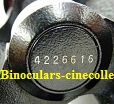 Pict 10; 7x50W Jenoptem production number placed on the washer (Pict 12); © Anna Vacani Pict 10; 7x50W Jenoptem production number placed on the washer (Pict 12); © Anna Vacani
Internal features
The binocular is Porro I optical construction. The lenses of the binocular are single coated.
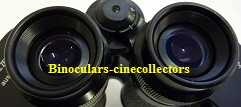 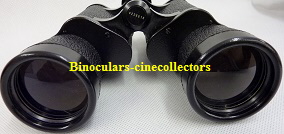
Pict 11, 12; 7x50W Jenoptem with single coated lenses; No 4226616;© Anna Vacani
In 1978 the binoculars produced by Carl Zeiss Jena DDR were manufactured with multi-coated lenses. It was specified on the right plate of a binocular.
It is identical optically and mechanically to the early 7x50 Binoctem model. The binocular has original type prism seats and double skin objective tubes.
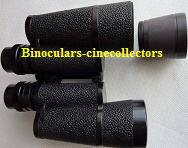 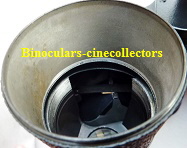
Pict 11; 7x50W Jenoptem with double skin objective tubes; © Anna Vacani Pict 12; The prism seats in 7x50W Jenoptem; © Anna Vacani
On the later multicoated models the optics are the same, except the prisms are bigger and the body does not have a good prism seats. And the objective tubes are single piece of metal carrying the outer cover.
It is possible to change the multicoated optics into an early model single coated optics, but you cannot change the prisms.
The binocular dimensions are:
Width (fully extended) over the prism house -180 mm (7,08 in) and underneath of the objectives - 200 mm (7,87 in); height - 180 mm (7,09in); weight 1024 gramm (2,25 lb).
|
|
|
|
|
|
|
|
Page Back pages: (1) (2) (3) (4) (5) (6) (7) (8) (8a) (9)
|
|
|